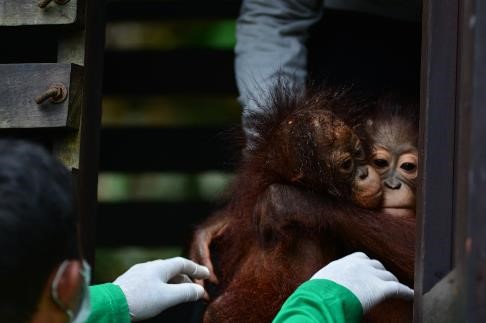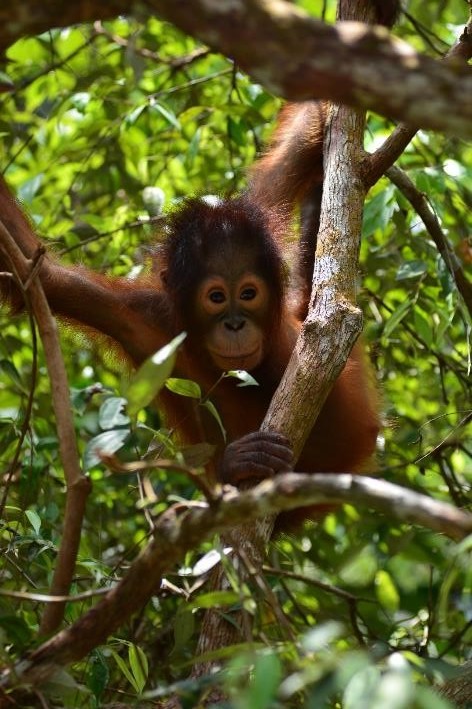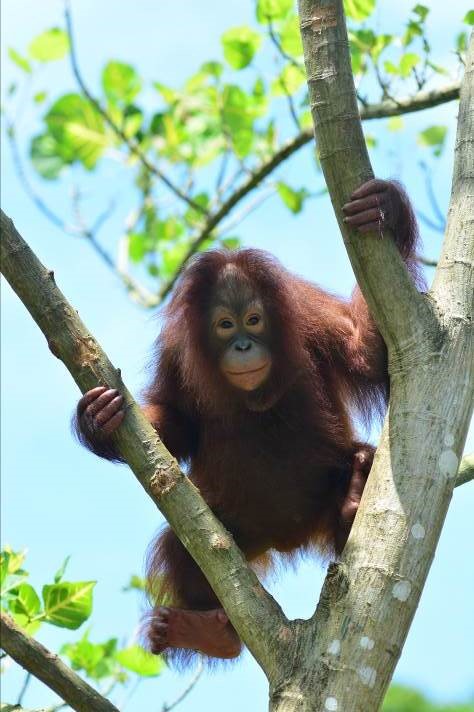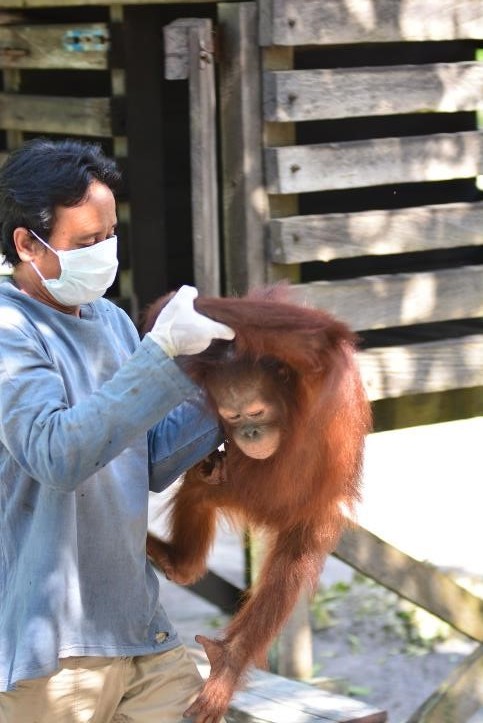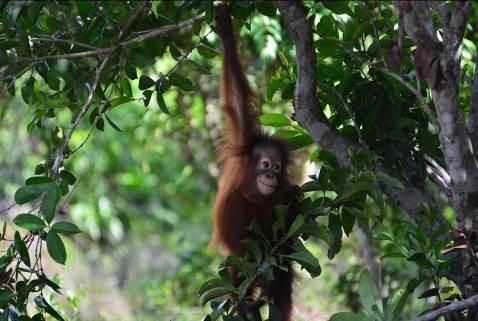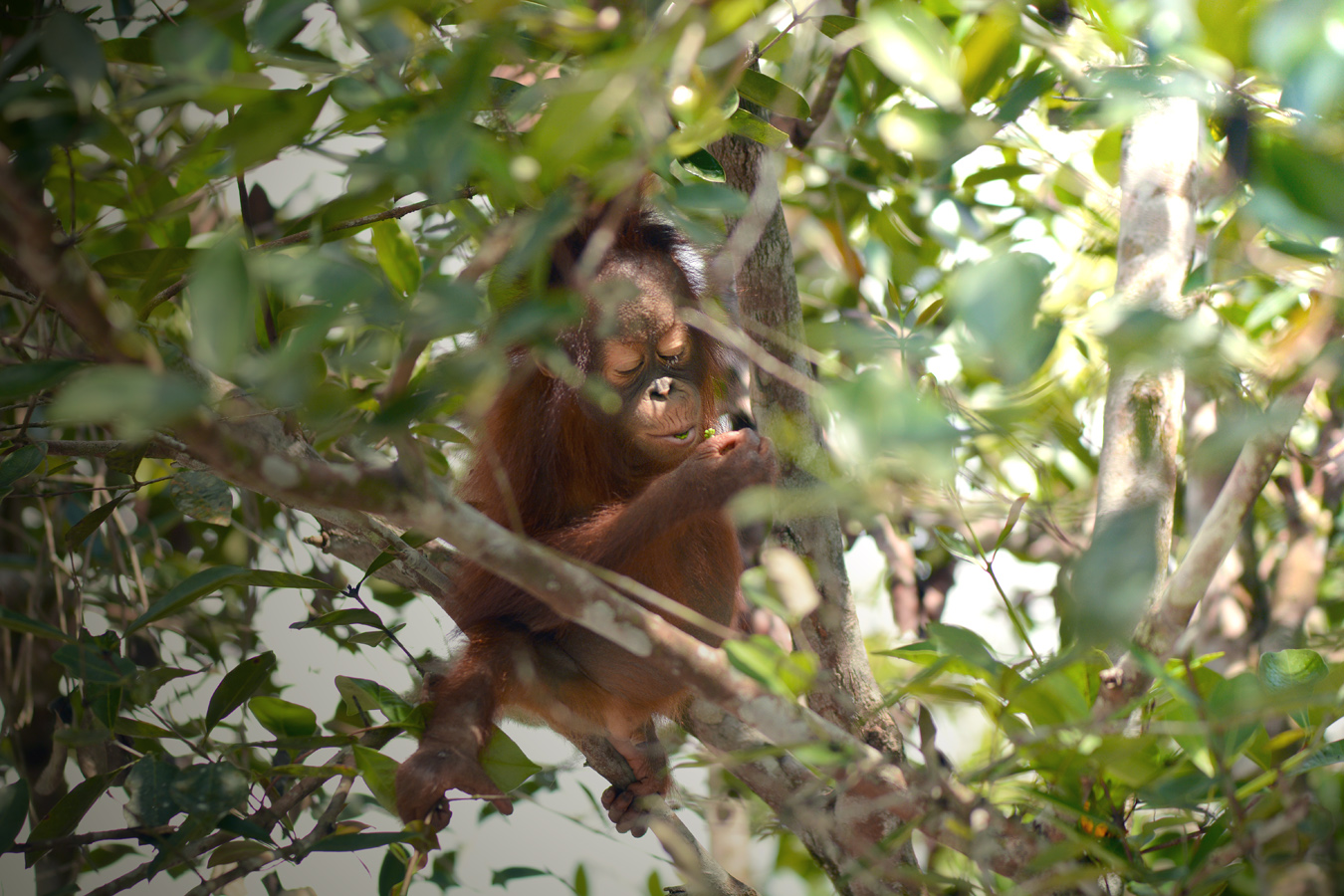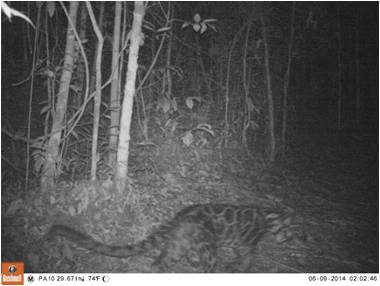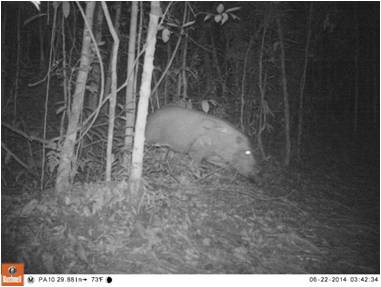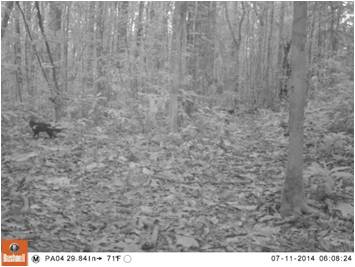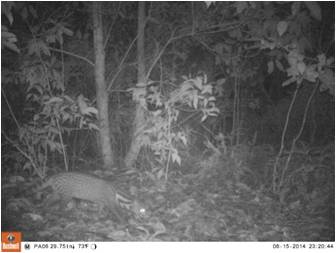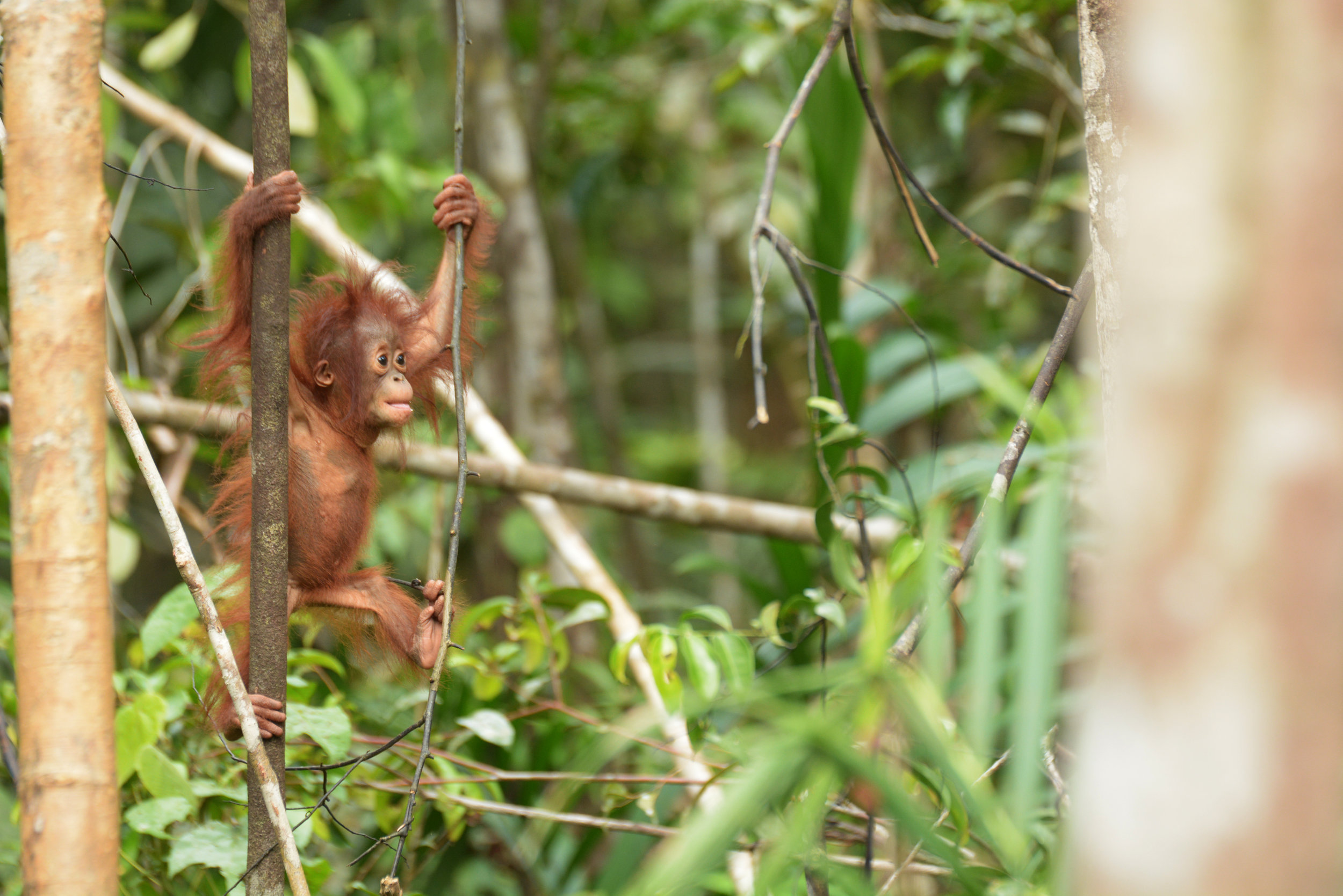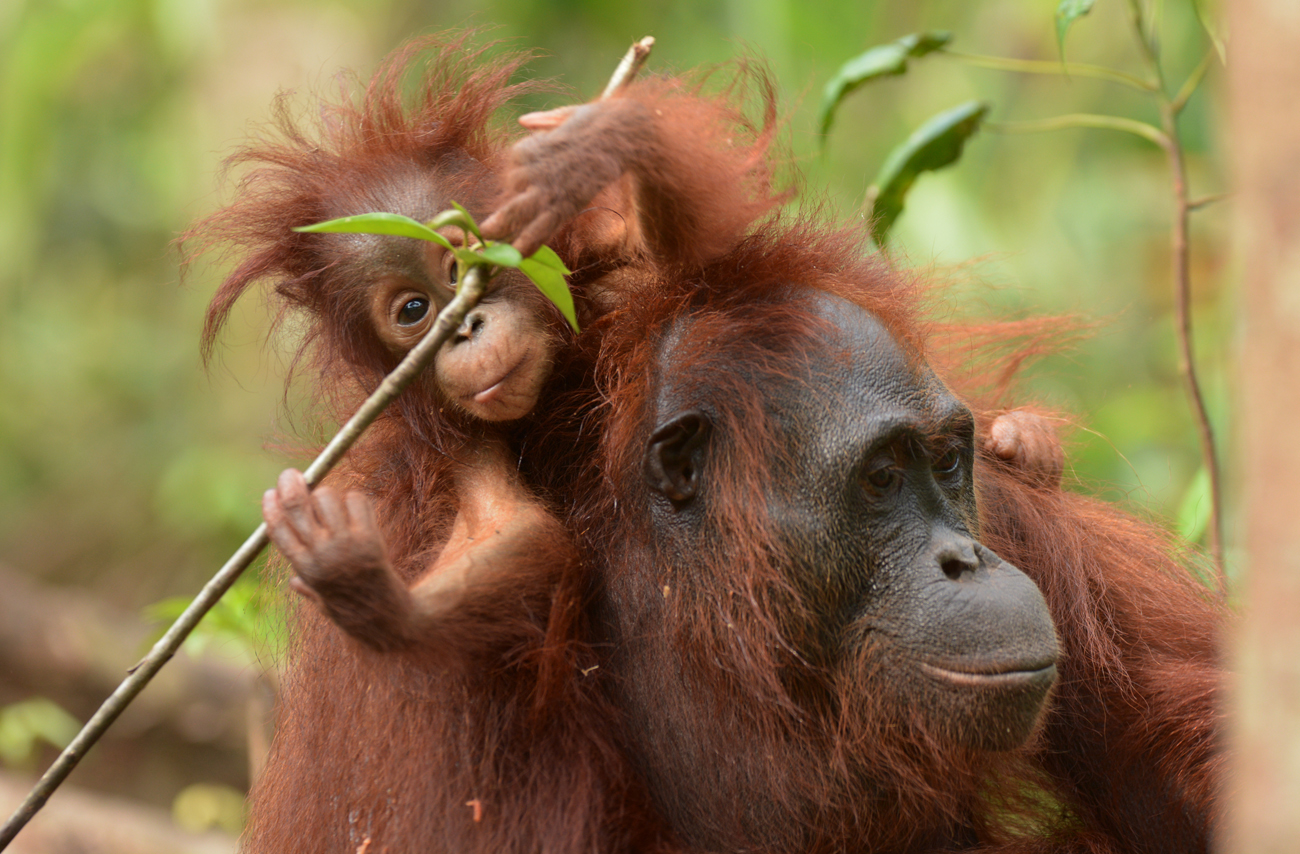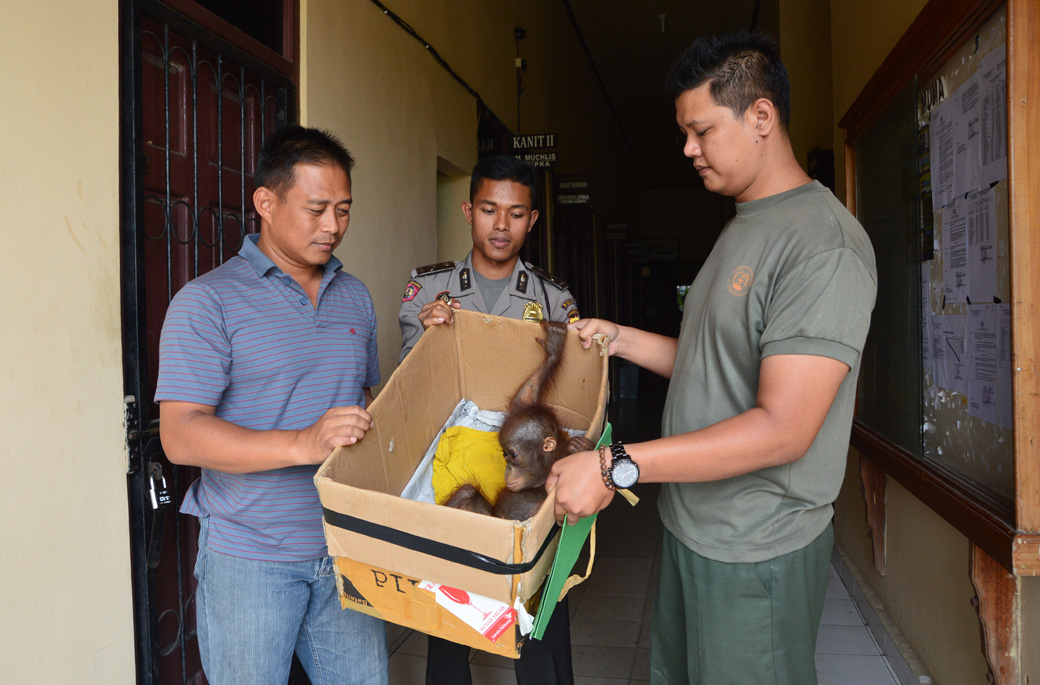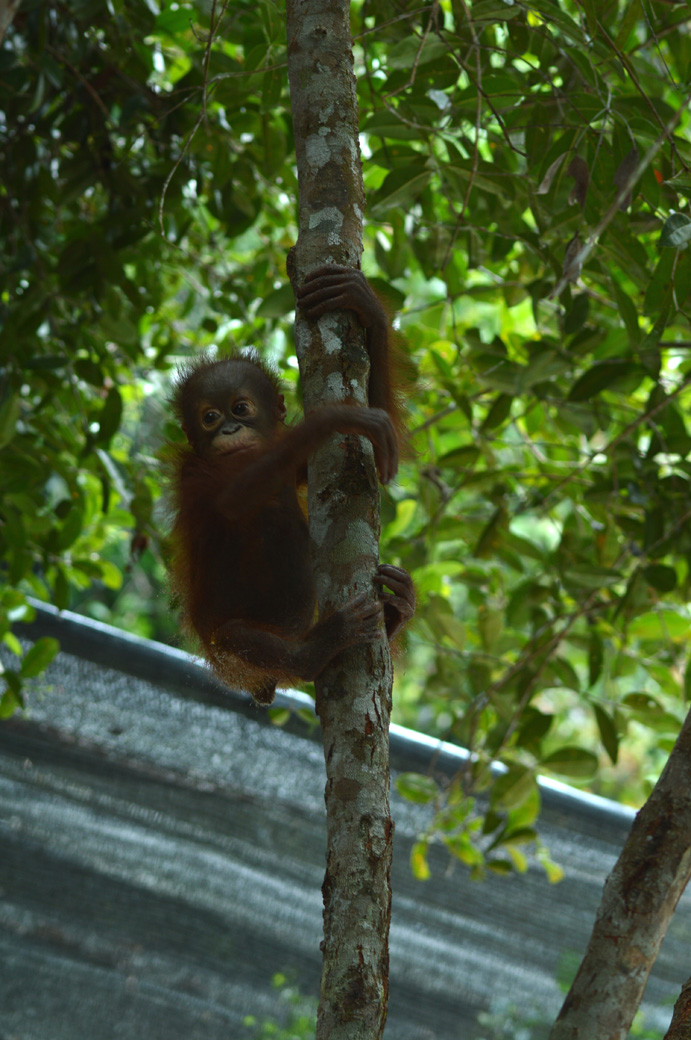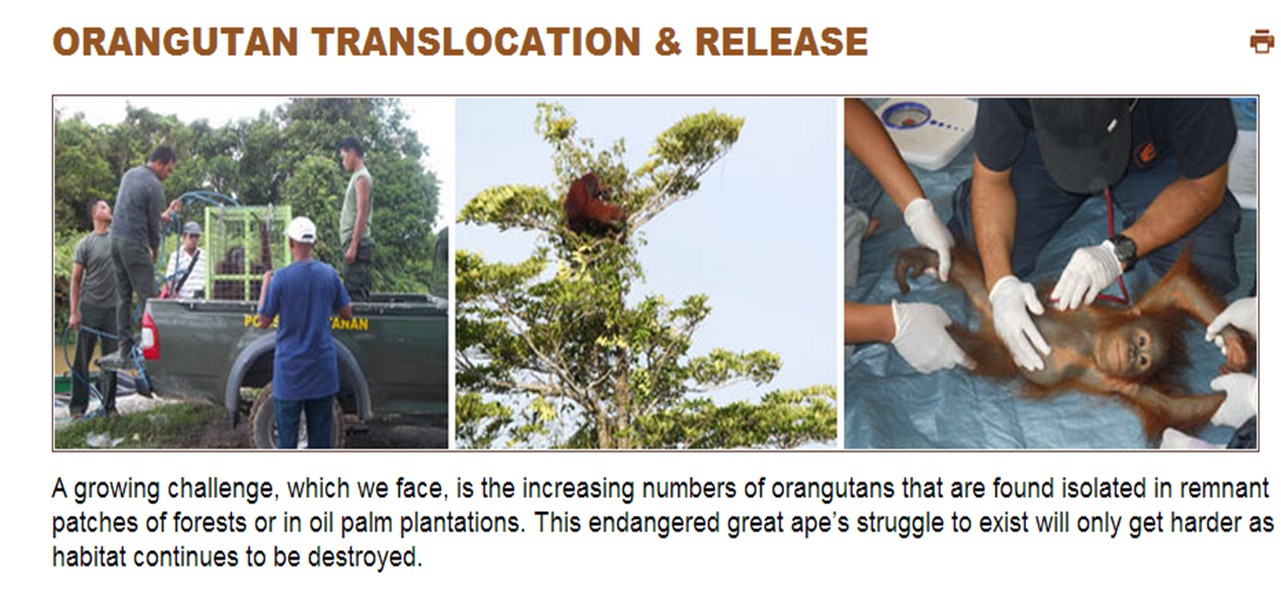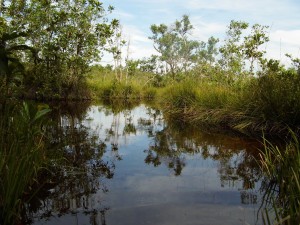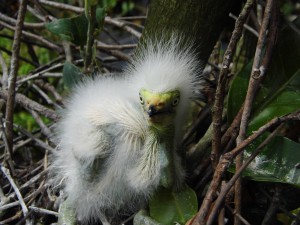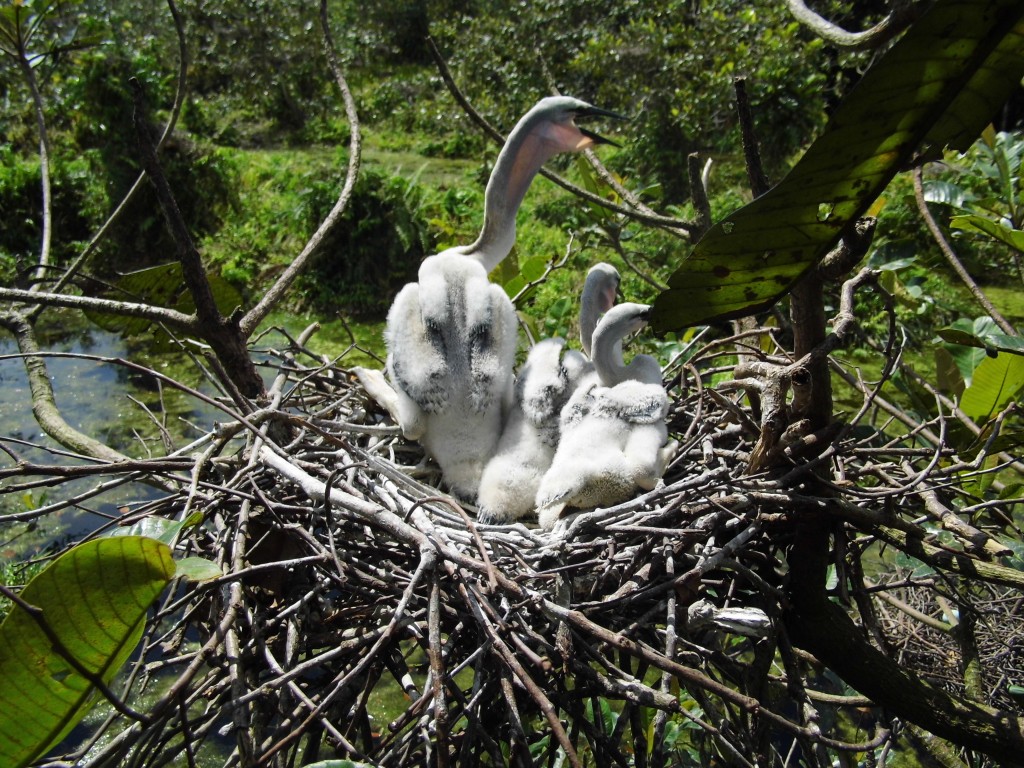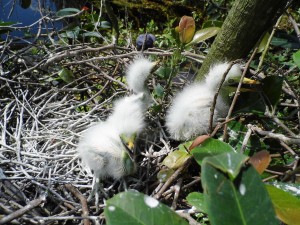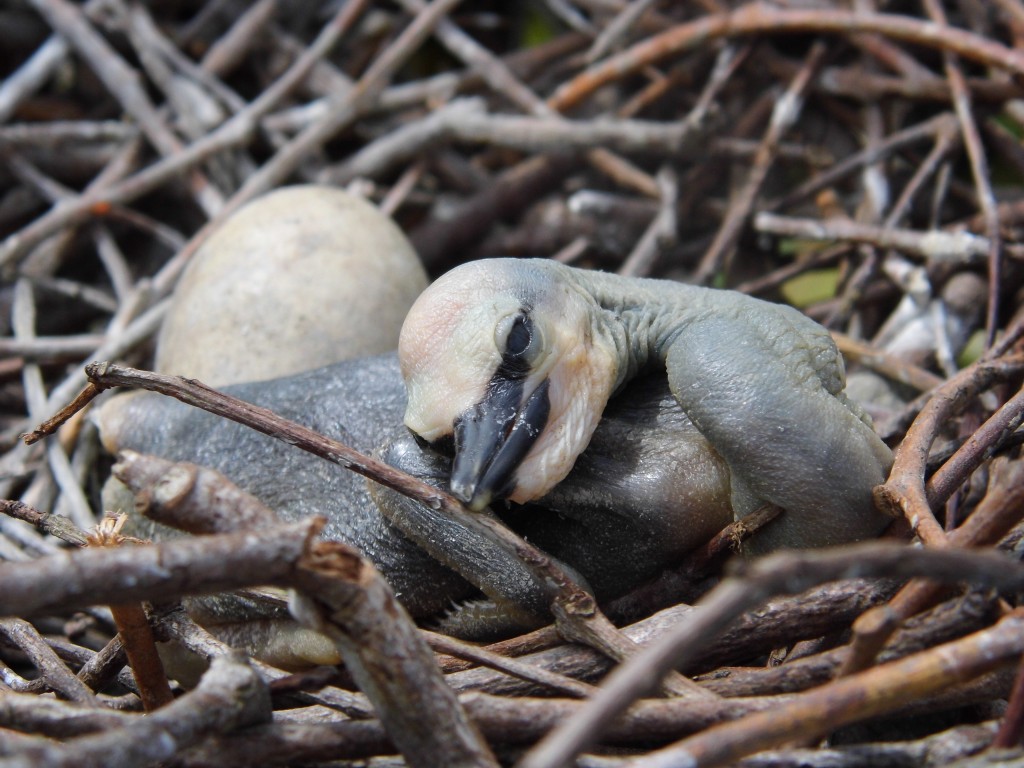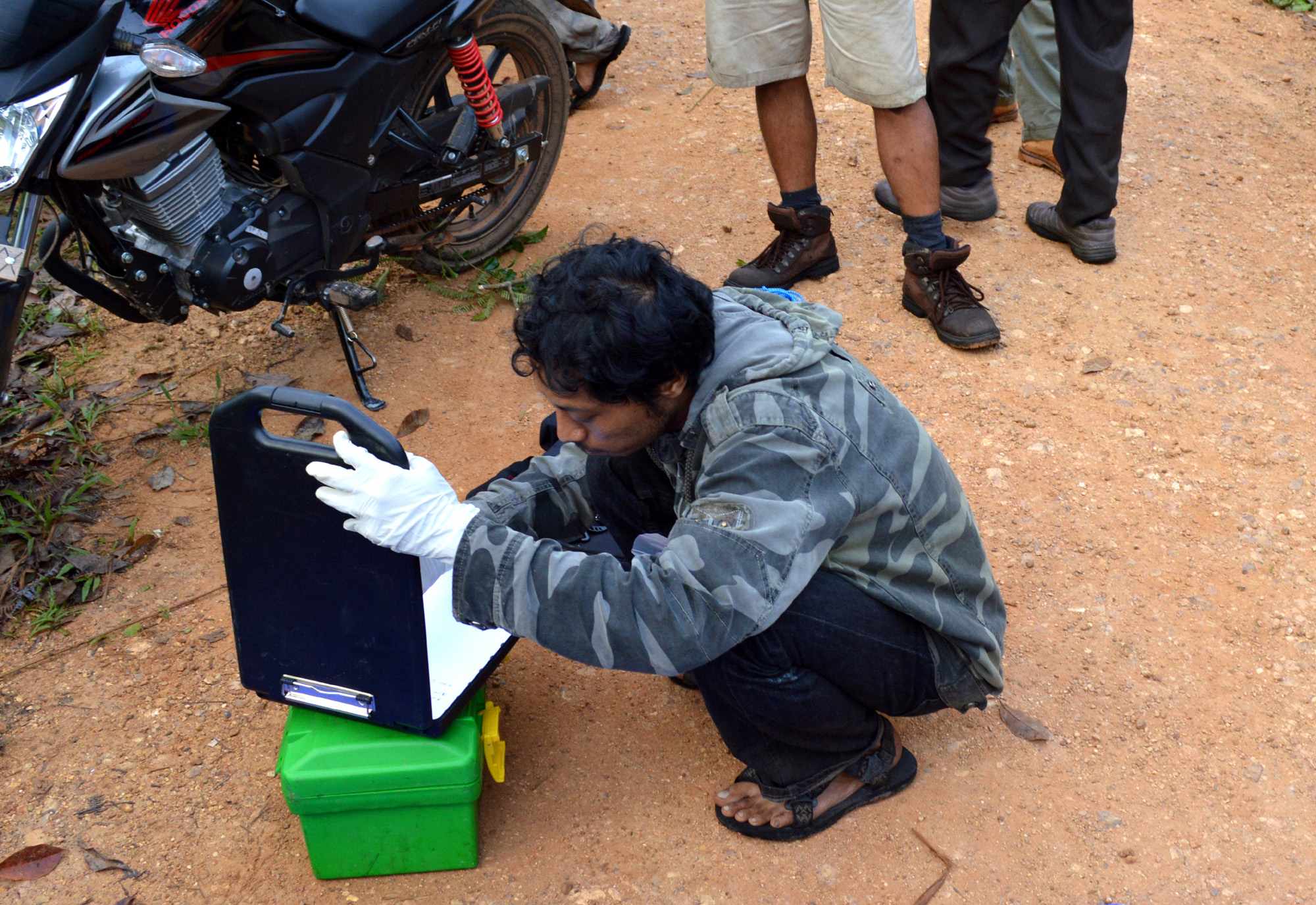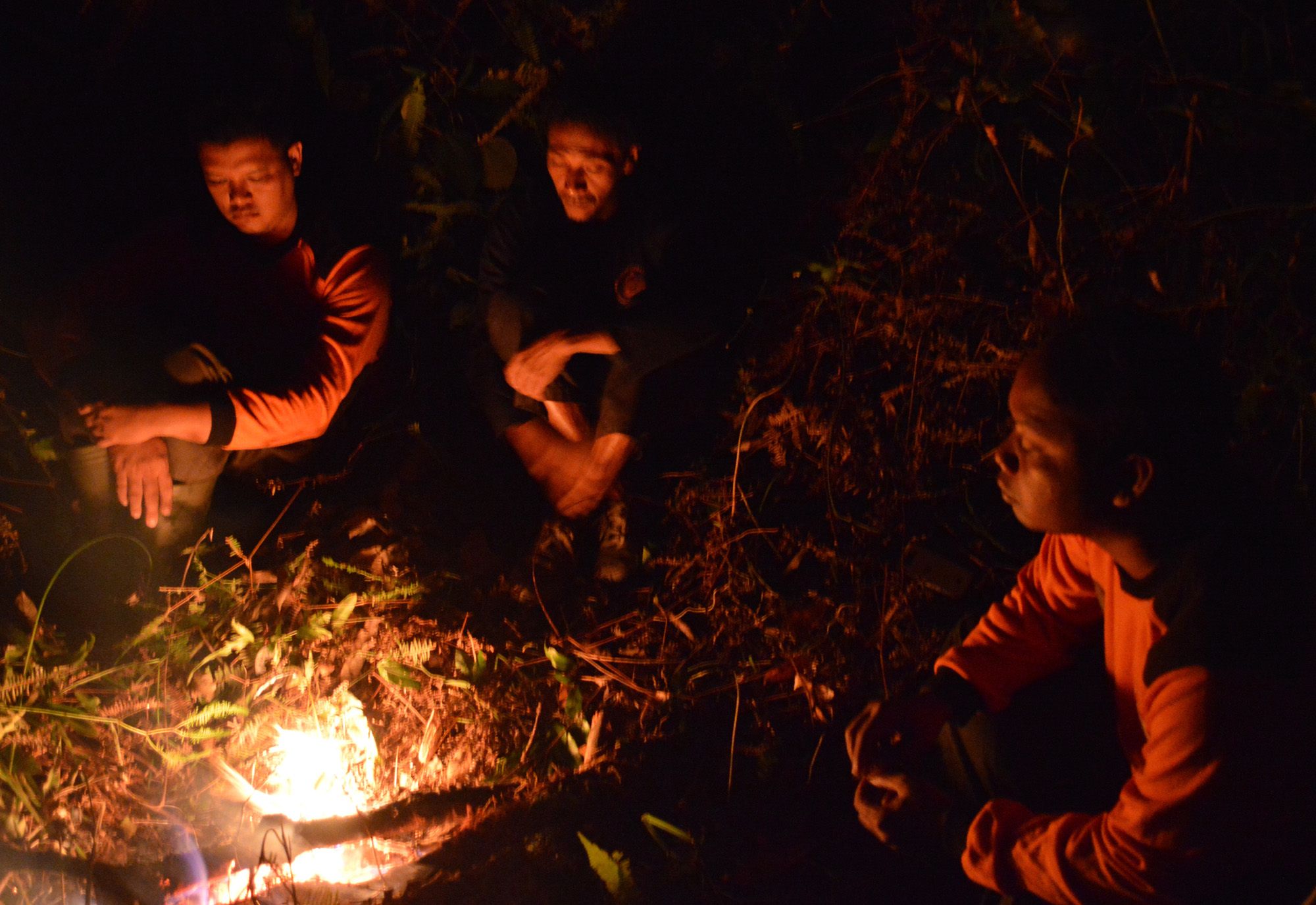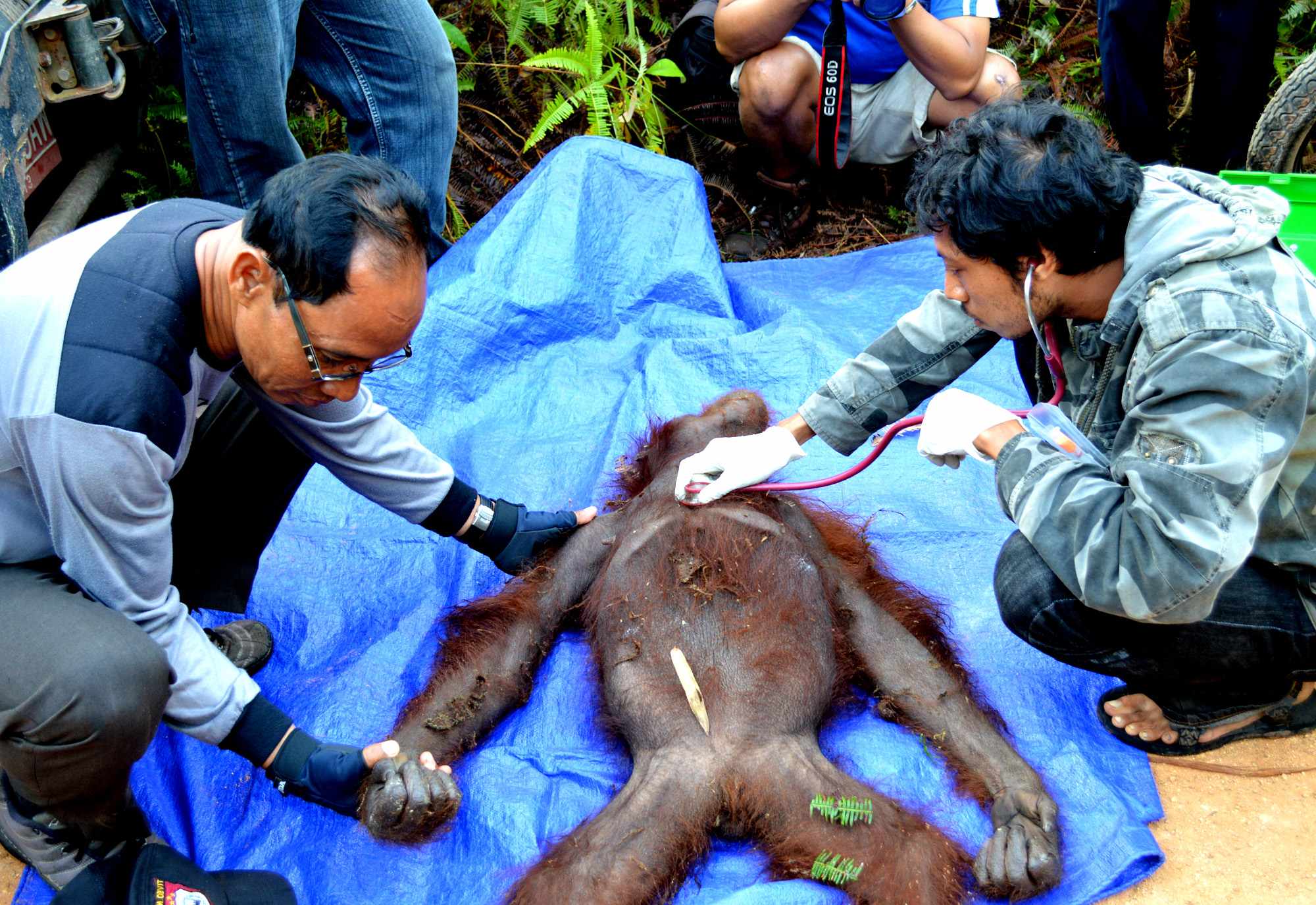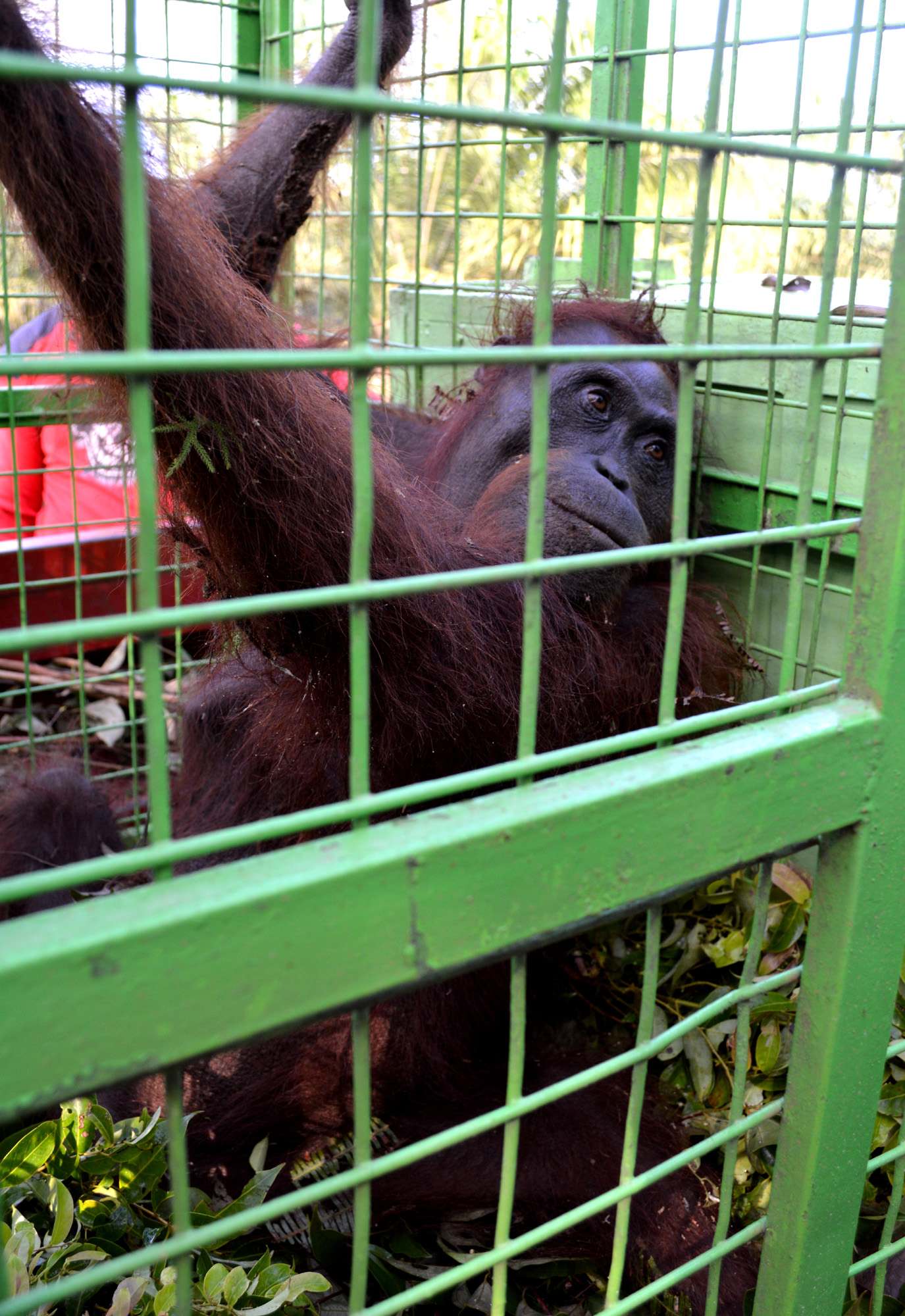Have you ever wondered what it’s like to be an orangutan carer? In the depths of Borneo’s forests, our camps support orphaned orangutans on their journeys back into the wild - and it is the carers that are there for every step of the way. In this ‘In Conversation’, we catch up with the carers of latest release Mona.
In Conversation: a day in the life of an Orangutan Foundation veterinarian
Orangutan Stories: Sony lends a helping hand to his sibling!
Peat swamp forests: the critical home to the orangutan
2024 highlights: A look back on our conservation achievements together for orangutans, forests, and people
Images of Max's newborn orangutan, born in the wild
We have just received these delightful images of Max and her newborn infant. Max and her mother Mantra, were released into the Lamandau Wildlife Reserve in 2003, aged 16-years old, this is Max's pregnancy.
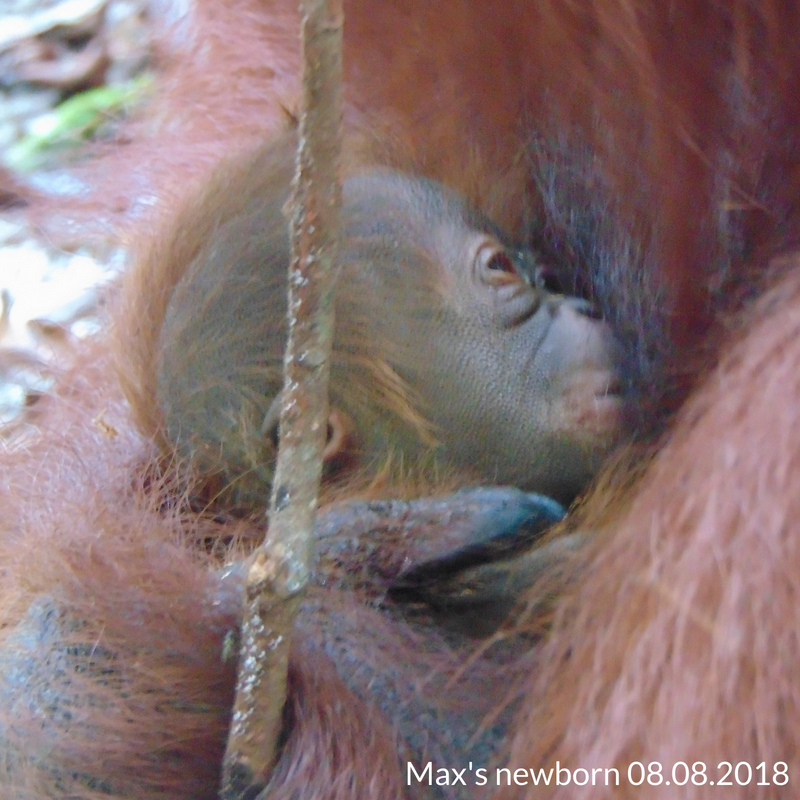
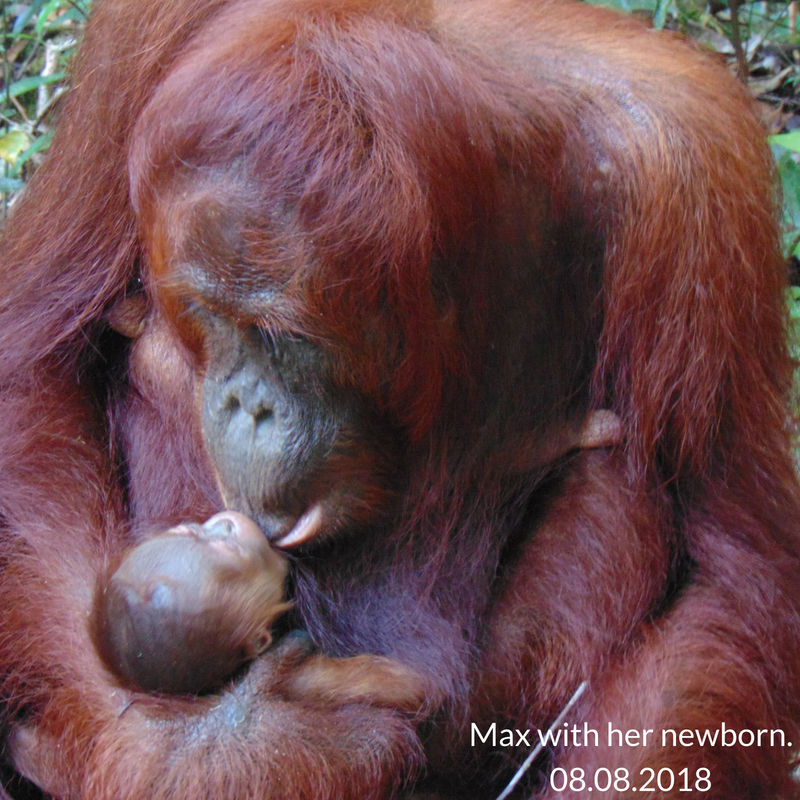
Max looks to be doing well but her infant seems quite weak. Staff will provide supplementary fruit and will follow Max for a week to monitor her and her infant during these critical early days.
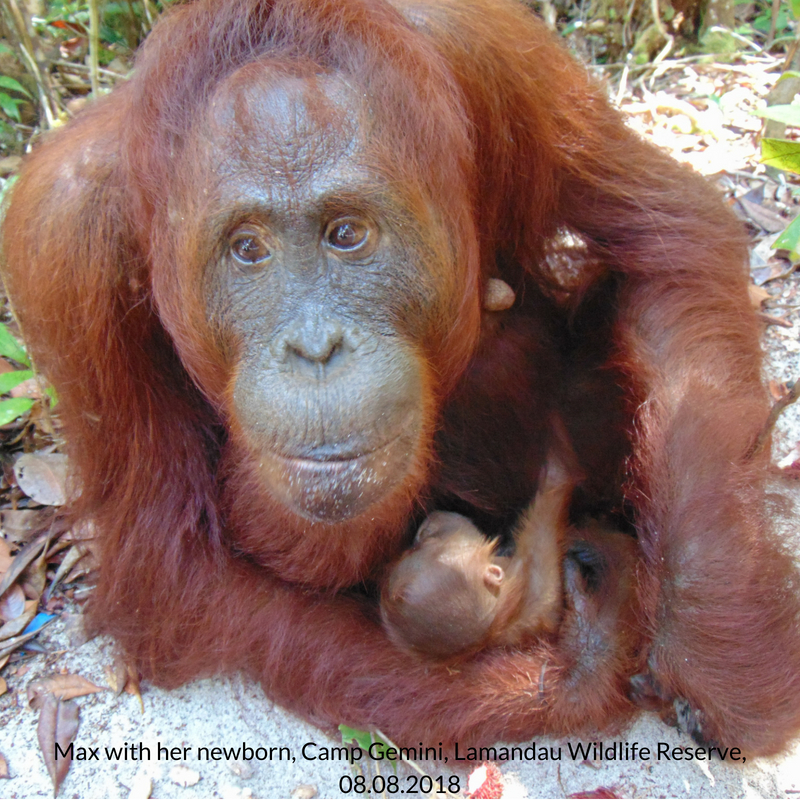
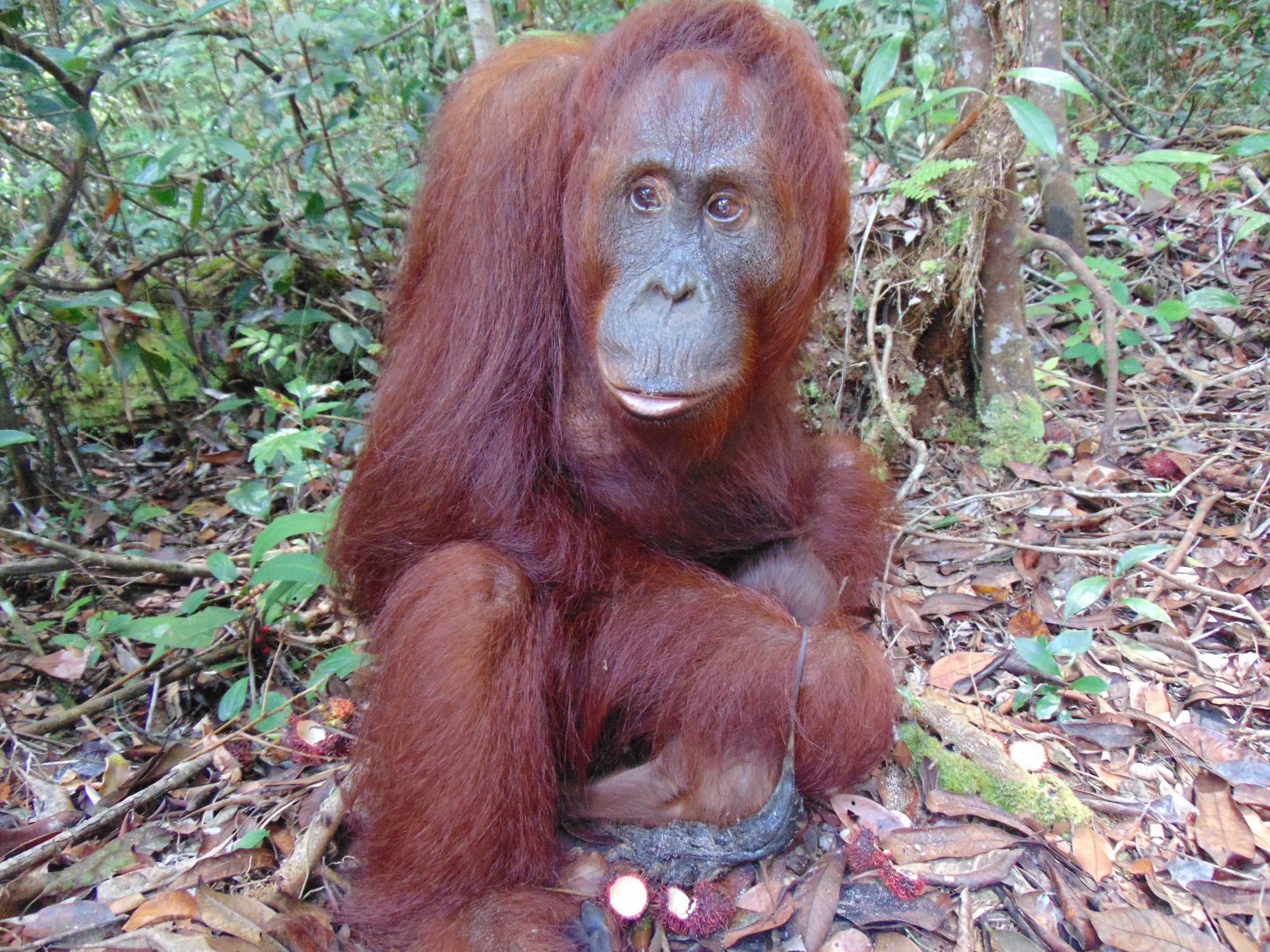
Wild orangutan rescued and moved to safety
When our staff arrived at the oil-palm plantation they found the orangutan in an area of forest, on the riverbank of the plantation. We had been called in to help by BKSDA SKW II Pangkalan Bun (government agency for wildlife) who had received reports from an oil-palm plantation of an orangutan in their plantation. It was decided to capture the orangutan and move her to the protected Lamandau Wildlife Reserve, to avoid potential conflict.
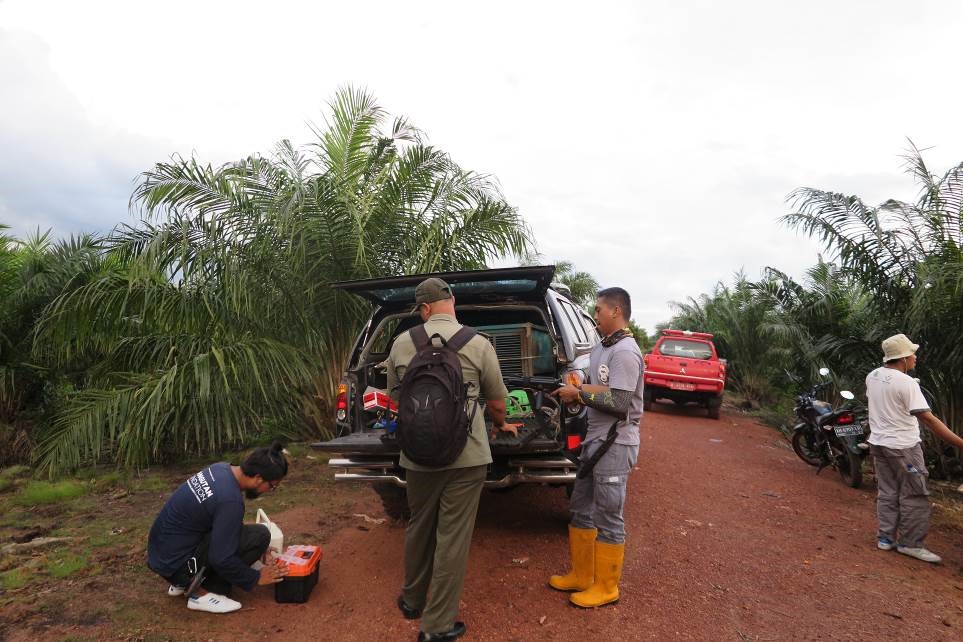
The orangutan, who they identified as female, had made and was resting in a nest. This made it easier to dart her as she wasn’t moving.
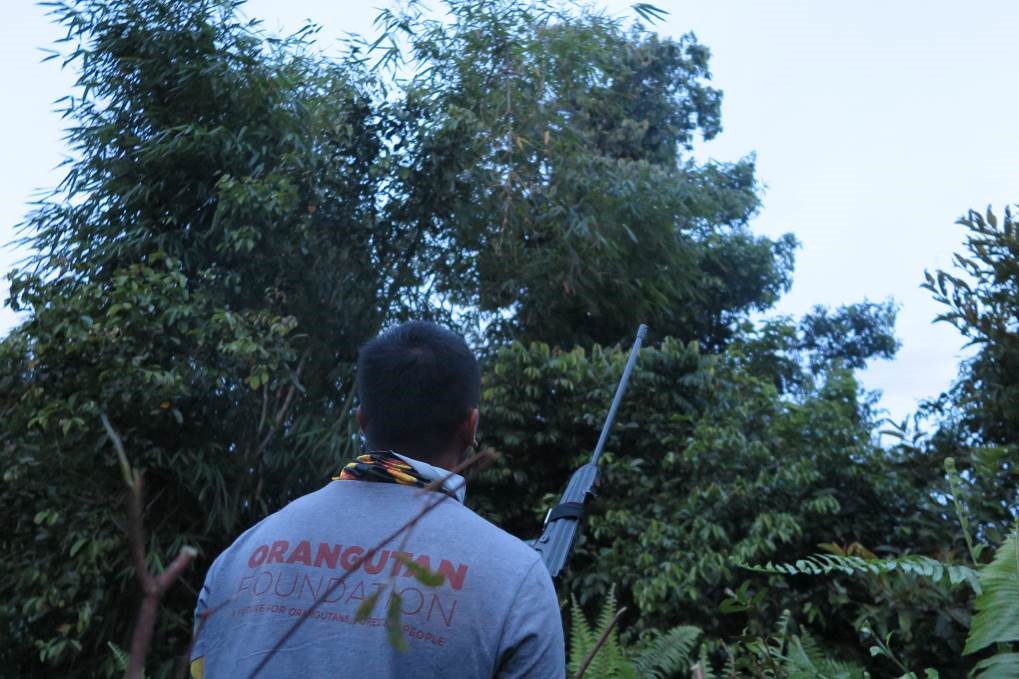
What our staff hadn’t anticipated was that she might just remain where she was and fall asleep, making it very difficult to then rescue her. This is just what happened!
One of our rescue team staff, Mr Nasibah, also an expert tree climber, shinnied up the tree to the nest. With huge effort he managed to lower the unconscious orangutan out of her nest. Our staff on the ground, used netting to catch her, as she fell to the ground.
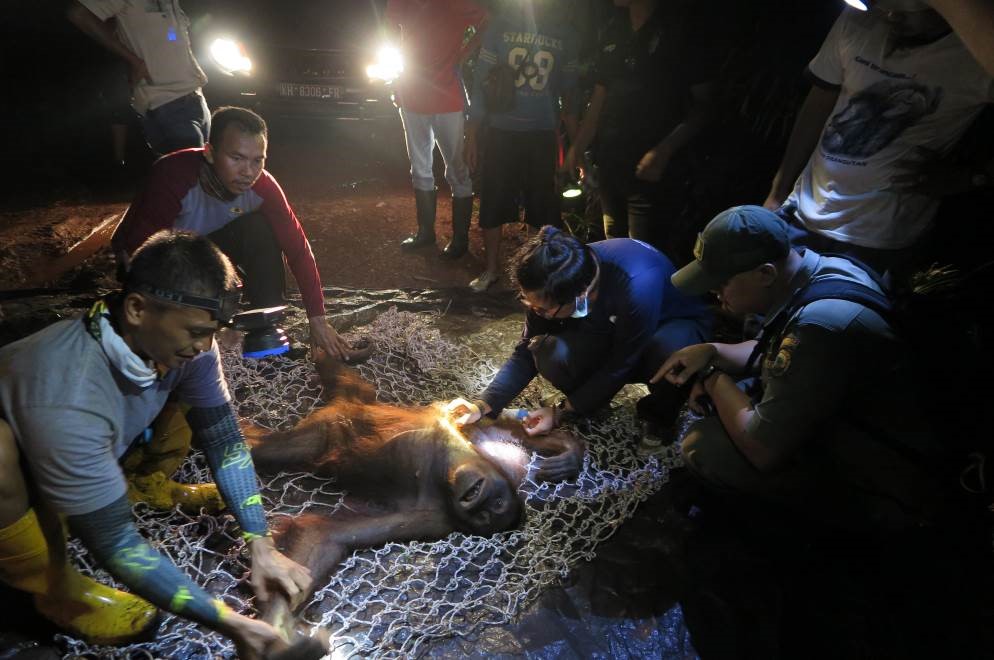
She was quickly transported to an open area where our vet Dr Dimas, examined her. Apart from a small scratch to her chest, she was in full health, weighing 45 kilos and was thought to be around 18 years-old. The scratch was cleaned and injected with long-acting antibiotics to prevent infection.
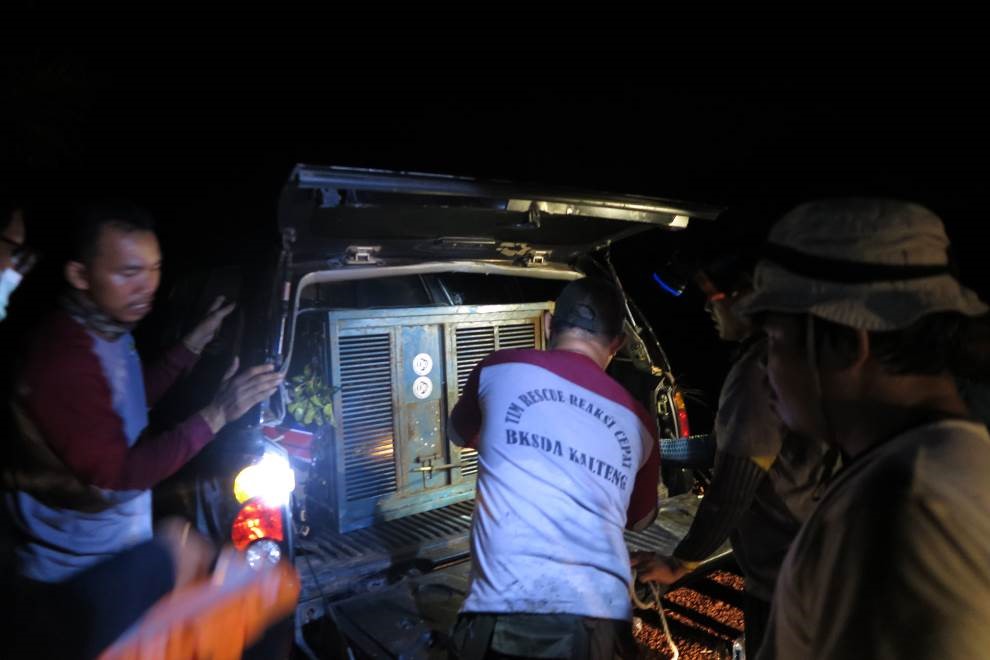
Two days later the orangutan was released in the Lamandau Widlife Reserve, on the opposite side of the river from Camp JL. We protect this forest reserve with guard posts and regular forest patrols to prevent and deter illegal activities.

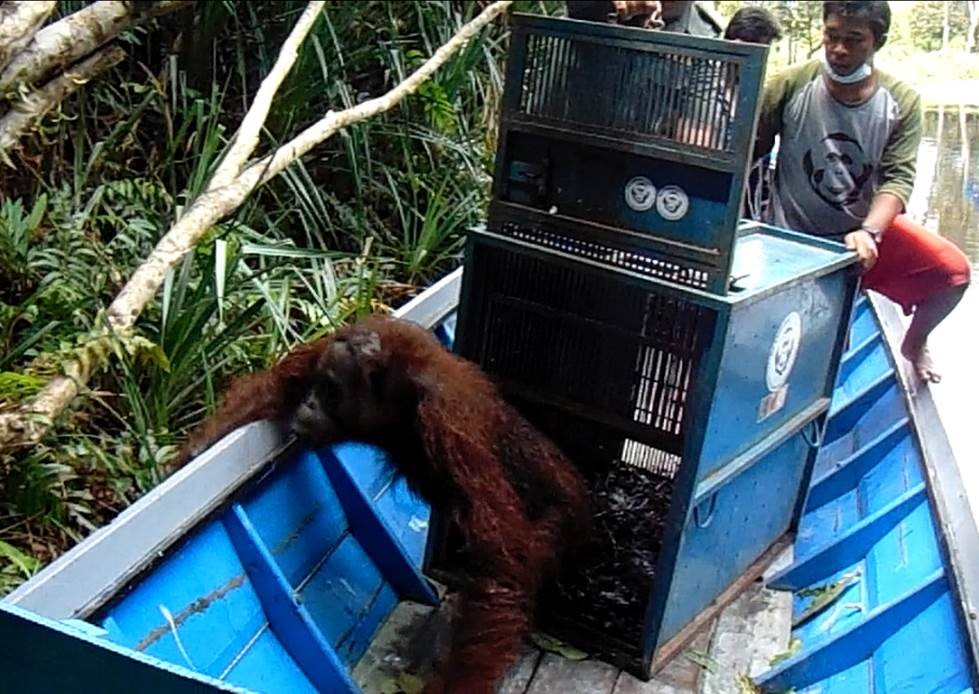
As soon as the transport cage door was opened she actively climbed into the nearby trees and disappeared into the forest.This, we hope, is her last encounter with humans.

The Lamandau Wildlife Reserve totals 158,144 acres of tropical forest and is home to a population of more than 500 orangutans. Half of these were reintroduced or translocated and given a second chance of survival in the wild. We must make sure they are stay safe. Please donate to our urgent appeal – DONATE TODAY
Protecting orangutan habitat
We only send out appeals when there is a real need for help – and right now, we urgently need funds to strengthen the protection of the Lamandau Wildlife Reserve, habitat of the critically endangered orangutan. In January and February, our forest patrol staff detected and tackled fires, deliberately lit to clear land, next to the reserve. They prevented the fires from spreading and saved thousands of acres of peat swamp forest from going up in smoke. In March, we met with the provincial government to push for those responsible for starting the fires, to be held to account.
The Lamandau Wildlife Reserve totals 158,144 acres of tropical forest. The Foundation's staff put themselves at risk as they battled to protect the forests, home to a population of 500 orangutans. Half of these were reintroduced or translocated by the Orangutan Foundation and given a second chance of survival in the wild. We must make sure they are safe.
It costs a quarter of a million pounds a year to protect the reserve and the wildlife. A significant commitment for a small charity, but a relatively small amount considering the invaluable riches and services the forests contain and provide.
The Orangutan Foundation runs and staffs eight guard posts in and around Lamandau to deter and prevent access to the forests. Our staff, all committed local Indonesian conservationists, patrol on foot or by boat. We use conservation drones and GIS to map and document illegal activities.
The map below shows the guard posts (red triangle on blue).
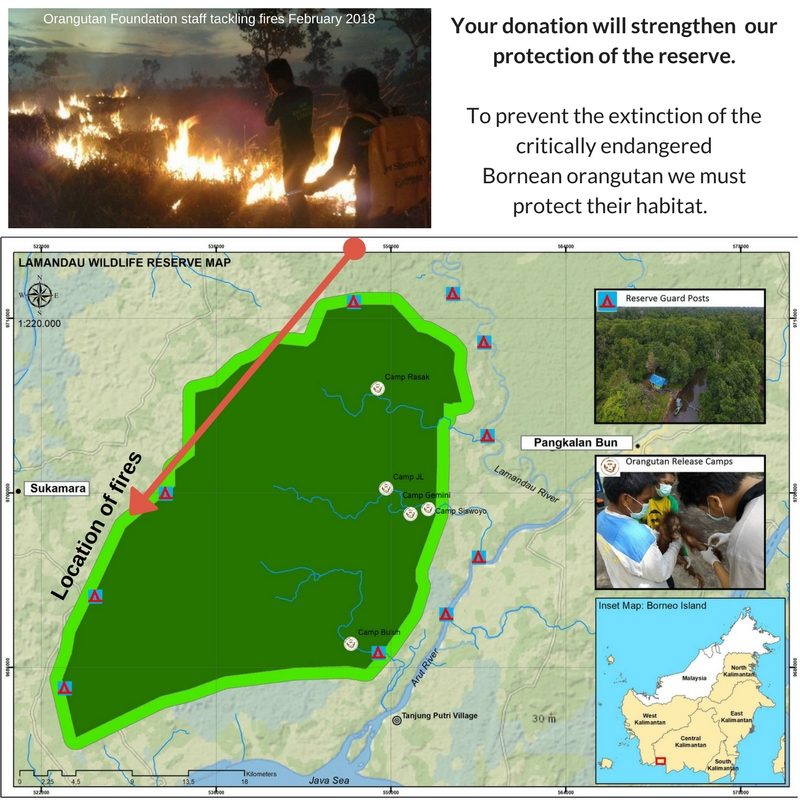
In 2017, we stopped illegal mining inside the reserve and since the beginning of 2018, our forest patrols have detected and stopped two cases of illegal logging.
Yet, despite years of investment in successful community awareness, there remain a small few who want to exploit the forest for their own interests. As pressure for land increases our fight to protect standing forest, to stop it being logged or converted to oil palm, will only become more difficult. Protecting Lamandau is an ongoing commitment: we cannot temporarily close a guard post due to insufficient funds, in the hope that we might start up again next year. If we stop protecting the reserve, we know that we will lose it: the forest and its precious wildlife could be gone in an instant.
Bangkal is one of the orangutans at risk. Originally released into the neighbouring Tanjung Puting National Park, Bangkal was severely injured in 2000 when illegal loggers attacked him with boiling-hot oil. Following a long period of recovery, he was released into Lamandau, at Camp Gemini, one of our five release camps in the reserve. Bangkal, now strong, healthy and independent, has since become the dominant male.Aan, an adult female, was shot and permanently blinded in an oil-palm plantation. Foundation staff moved Aan to the Lamandau Reserve, where she now lives with round-the-clock monitoring by our staff and vet.
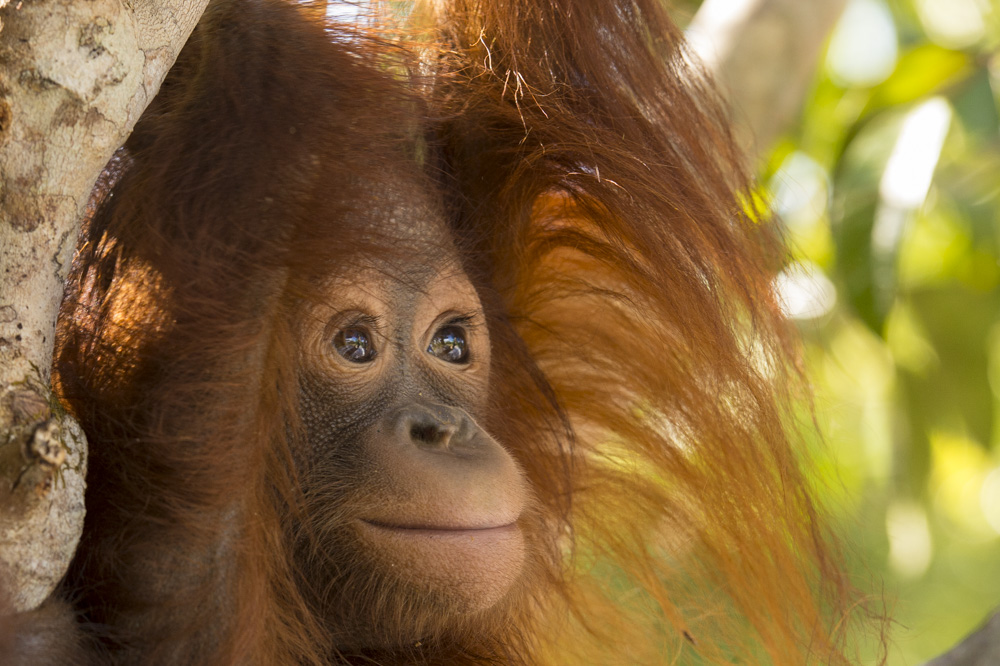
We also care for ten orphaned infant orangutans at our release camps - plus many dozens of reintroduced and translocated adults that are thriving in the wild under our protection. We owe it to these orangutans to keep their forest home safe.
Please DONATE SECURELY THROUGH OUR WEBSITE, by calling 020 7724 2912, or by sending a cheque payable to ‘Orangutan Foundation’ to Orangutan Foundation, 7 Kent Terrace, London, NW1 4RP. If you are unable to donate immediately but want to make funding pledge, whether through fundraising or a delayed donation, please contact us to discuss options – we will work with you however we can.
Sponsor the protection of Lamandau Wildlife Reserve
- £15 protects 10 acres of forest for one year
- £37.50 protects 25 acres of forest for one year
- £75 protects 50 acres of forest for one year
- £150 protects 100 acres of forest for one year
We must act today to secure the future for orangutans, forests and people.
With sincere thanks,
Ashley Leiman OBE
Founder & Director/Trustee
![]()
Wonderful images of young Bornean orangutans learning to survive in the wild
Here’s another field update, with some wonderful images, from Orangutan Foundation vet Steven Daud, on some of the younger orangutans in the Lamandau Wildlife Reserve, Indonesian Borneo. A couple of days ago, we made our routine health and monitoring visits to Camp Rasak and Camp JL, two orangutan release camps, within the Wildlife Reserve. This journey is by speedboat as the camps can only be accessed by river.
Our first stop was Camp Rasak, where orangutans Jessica, Timtom and Endut live. These orangutans are on a soft-release programme.
We took Jessica, Timtom and Endut out from their enclosure so they can learn to make a nest and play in the trees. Jessica’s ability to make the nest is clearly visible. While Timtom and Endut are seen to be very brave exploring the trees, where they hone their skills of survival.
Nowadays, the weather is unpredictable which has caused Timtom to catch a cold. We are giving Timtom vitamin supplements and medication to help her get healthy again.
After Camp Rasak we got back into the speedboat and went to camp JL to monitor Okto and Ketty. Before orangutans can be fully released back into the wild they must be able to make a nest to sleep in. Ketty has shown that she can make a nest. However, Okto still has difficulty with this skill and sometimes even tries to interrupt Ketty's nest-building.
In terms of health, Okto and Ketty are both in good condition and this is maintained by giving them vitamin supplements. To minimise disease transmission between the orangutans and humans, staff in contact with the orangutans must wear gloves and masks.
I hope you enjoy the photos.
Regards,
Steven (Orangutan Foundation Vet)
As always, we are immensely grateful to the Orangutan Foundation staff in Indonesia for their hard work and commitment. You can support this work by Adopting Okto (a unique Christmas present of real value) by visiting our online shop. There are plenty of other wonderful Christmas present ideas too. Last day for ordering before Christmas is Friday 16th December. Thank you.
The Fruits of Our Labour
 Spring has brought with it a plentiful fruiting season to Lamandau Wildlife Reserve, meaning orangutans don’t need to be visiting our camp feeding sites to compensate for food shortages anymore. Because of this, our field staff aren’t seeing nearly as many orangutans as they did earlier in the year!
Spring has brought with it a plentiful fruiting season to Lamandau Wildlife Reserve, meaning orangutans don’t need to be visiting our camp feeding sites to compensate for food shortages anymore. Because of this, our field staff aren’t seeing nearly as many orangutans as they did earlier in the year!
That is why we were especially excited to catch a glimpse of one of our rescued orangutans, Okto, playing in the trees this week. As a young juvenile, Okto has been part of our soft-release programme for the past 6 months. This programme is for young orangutans that need extra monitoring and care. They are taken daily to the forest to learn about their natural food resources and to practice their climbing.
Now that the fruiting season has begun, Okto has been seen to be enjoying climbing as well as finding all the right fruits to feed himself with. This comes as wonderful news to the Foundation, as it is proof that our soft-release programme is good preparation for an orangutan to survive in the wild.
[Okto eating ubar fruits]
[Okto not eating ubar fruits…]
From fruit garden to forest refuge...
Whilst orangutans are found in oil palm plantation or community land, it means their habitat is still shrinking. However these orangutans can still have a safe future in the Lamandau Wildlife Reserve. Already this year two orangutans have been rescued and translocated into the Reserve. This is Kuala’s story, sent by one of our staff, a six year old male, he had been damaging the village garden of Mr Joko. Mr Joko kept him for over a week, before a neighbour pointed out that orangutans are a protected species. Mr Joko then contacted the BKSDA who, with the Orangutan Foundation's vet and staff, travelled to the village 'a 10 hour journey from the Foundations office', where Kuala (named after the village) was handed over.
After all the required health checks were clear he was able to be transferred to the Reserve.

Seemingly impatient to be back in the forest, Kuala stood rattling his cage and looking upwards at the trees. Once the cage door was opened he surveyed his surroundings and then without hesitation was straight up a tree. He was moving so quickly from tree to tree that it was difficult for the staff monitoring him to keep up, but by the end of the day, they were able to see he had already made his night nest, back in the wild where he belongs, and safe. He was monitored for the next ten days.
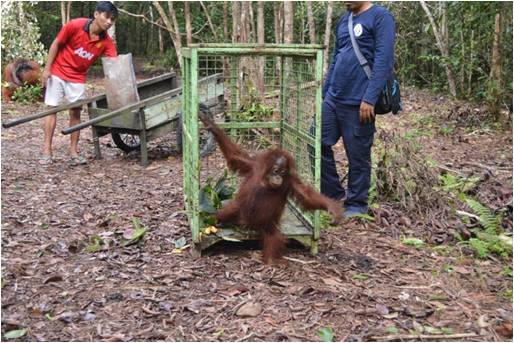
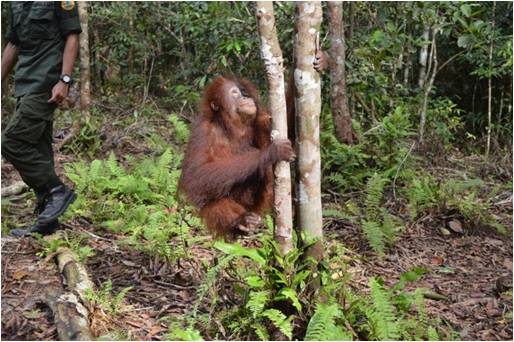
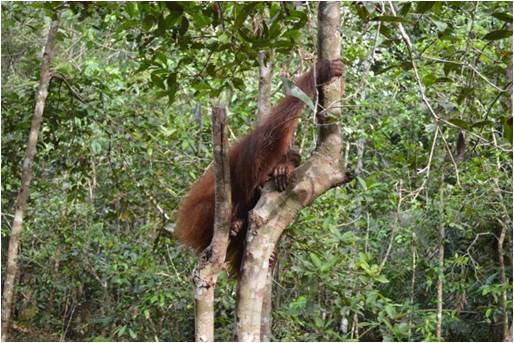
Exciting start to the New Year!
Sheila gave birth to her third offspring on the 15th of December 2014. We don't yet know if it's male or female. Her nurturing instinct is obvious from just looking at the photos. This birth is a testament to the ideal habitat she lives in, and to the conservation work that protects this area; the Lamandau Wildlife Reserve. The Foundation has always said, "If you protect the habitat, you protect the wildlife" - please read more by clicking here.
This offspring is a very good start to 2015, and two more are on the way ! 



Now it's New Year, we look back with confidence, knowing that we have made a difference...
The Foundation works in three areas of critical orangutan habitat. We extend the scope of our achievements by patrolling an area almost as large as the land area of Singapore. Our strategically located guard posts are therefore vital. We have been able to rescue more and more orangutans whose lives were in imminent danger. 75% of all orangutans live outside protected areas, so with our partners, we launched a campaign to collaborate with 18 oil palm companies for the protection of orangutans within the forests of their companies concessions and surrounding areas.
- In 2014, the Foundation translocated 17 orangutans into the Lamandau Wildlife Reserve.
- Torup and Kotim were rescued from community land and both are now in the ‘Soft Release’ programme, learning skills for an independent life in the wild.
- 2014 saw the birth of two infants, and two more orangutans are due to give birth in mid 2015.
- An exciting new initiative was the installation of camera traps in Pondok Ambung, Tanjung Puting National Park and Belantikan Arut. Without these camera traps, we would of never have had sightings of clouded leopards, one of the most elusive species of the tropical forest.

- The Volunteer Programme once again proved its worth, by renovating a Guard Post on a vulnerable river in the south of Tanjung Puting National Park.
- An important research project is the Population and distribution of the endangered banteng (wild ox), found in the Belantikan region. This is critical to the banteng’s future status.

- Thanks to the diligence of the Foundation staff, forest fires (an annual problem) were quickly identified and isolated, which prevented further areas of the forest from being burnt.
Thank you to all - your support really does make a difference and the orangutan foundation could not have achieved any the above without your help. A very happy New Year.
Wild cats and more! at the Pondok Ambung Research Site
This year the Foundation received a grant from the Rufford Foundation for a Camera Trap Programme at Pondok Ambung. This is an important development, as this research site is within the Tanjung Puting National Park (protected since 1982). Foundation staff have helped protect the park and the site since 1998. With this duration of protection, the park and its biodiversity has remained mostly undisturbed – a pristine forest in Central Kalimantan, Indonesian Borneo. The Foundation has hosted many students at Pondok Ambung - a chance for Indonesian students to conduct biodiversity research. Now with these cameras, we can catch a glimpse into more elusive wildlife...
Earlier this year, 10 camera traps were installed within the research site. The Foundation ensured there was no human activity in the study area for two months before the camera traps were installed. This lack of disturbance encourages more animals to travel past the camera traps. Foundation staff carefully selected the positions for the traps, and our hard work paid off!
Just one month after the camera traps were set up, we are excited to see the first collection of photos... as well as those shown below, we also have seen crestless fireback (Lophura erythrophthalma), lesser mouse deer (Tragulus javanicus), Bornean red muntjac (Muntiacus muntjac), pig-tailed macaque (Macaca nemestrina) and the Malayan porcupine (Hystrix brachyura)!
To get a snap shot into the lives of these rare and endangered species is truly special and important. Many of these creatures may be more endangered than currently listed (on IUCN Redlist – click here), so knowing where different species roam, and estimates of population size, are crucial.
It's fantastic to see this much biodiversity within 30 days. In this location, there is much potential for further scientific analysis. We look forward to future results - who knows what else we will see! To support the Foundation’s scientific research and the protection of orangutan habitat, please donate here or get in touch!
Amazing orangutans pictures...
These wonderful photos have just been sent to us from the field, all taken by Foundation staff in the protected Lamandau Wildlife Reserve. These re-introduced individuals, some who were re-introduced years ago, are now well known by the Foundation staff. Many of the females have had offspring since their re-introduction to the Reserve, living in a safe and healthy environment. With this window into their world, we can see how they are getting along...
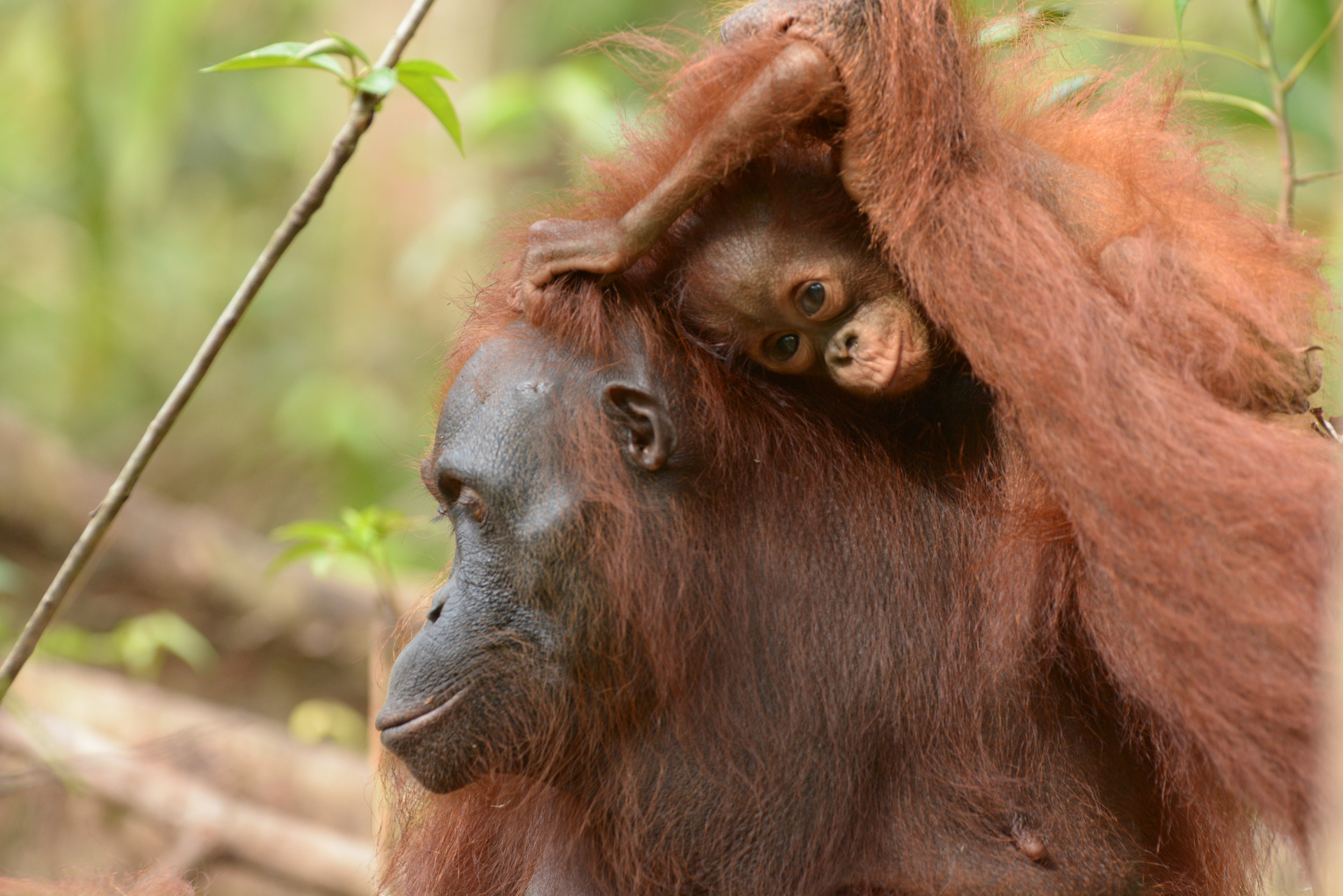
And still more orangutans to be rescued....
 The Foundation is always asked 'How is the situation - facing the orangutans?'. We answer 'The Foundation is making progress', in one way by working closely with villagers and oil palm companies to mitigate human-wildlife conflict'. This strategy is working, as the Foundation is called upon to rescue stranded orangutans, rather than the individuals being harmed. Within one week in April, the Field staff were called upon to translocate four orangutans that had entered villager's farm land. One orangutan was found in a chicken farm and had eaten bananas and coconuts from the orchard on her way! These situations must be extremely frustrating for the farmers and yet rather than injure the marauding orangutan, the local people now know that there is an alternative, and that is to call upon the Rescue Team (OF and BKSDA).
The Foundation is always asked 'How is the situation - facing the orangutans?'. We answer 'The Foundation is making progress', in one way by working closely with villagers and oil palm companies to mitigate human-wildlife conflict'. This strategy is working, as the Foundation is called upon to rescue stranded orangutans, rather than the individuals being harmed. Within one week in April, the Field staff were called upon to translocate four orangutans that had entered villager's farm land. One orangutan was found in a chicken farm and had eaten bananas and coconuts from the orchard on her way! These situations must be extremely frustrating for the farmers and yet rather than injure the marauding orangutan, the local people now know that there is an alternative, and that is to call upon the Rescue Team (OF and BKSDA).
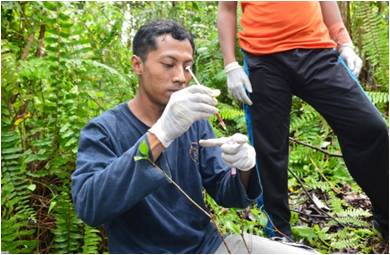
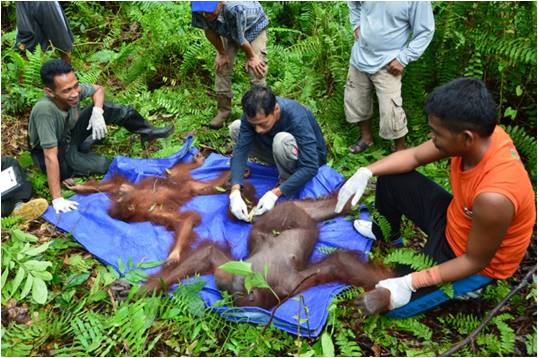
That same week, a female orangutan with two offspring was found in a farm of maize and bean crops. Again the land owner did the right thing by requesting that the orangutan be translocated. All these orangutans were given comprehensive health checks (see above), and when found to be healthy were re-introduced into the Lamandau Wildlife Reserve. Without protected areas such as Lamandau, the fate of these orangutans would be unknown. The reserve is a haven not only for orangutans. Recently a gibbon and a salt water crocodile were released (in fact in that very same week!). It is worrying that the loss of habitat is not decreasing, but through the Foundation's work on the ground and your support, we are able to give wildlife a protected future. Have a friend or an offspring of your own to read this story? Please do share on facebook(click here) or twitter(click here). Helping these individuals to be protected, you can read more and donate easily, supporting the Foundation. Thank you for reading!
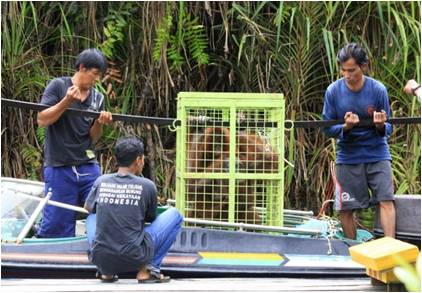
Introducing Keno!
On the first of March a policeman of the Sabhara Sukamara Police , Brigadier Kiki Tobing, was visting the small village of Laman baru on his day off, intending to buy durian (a famous Indonesian fruit). He could of never expected what happened next…

As he walked through the village, resident came up to him and, recognising Tobing as a policeman, handed him a baby orangutan. The orangutan had been found in an oil palm plantation close to the village. Tobing named the orangutan infant “Keno”.
Orangutans enter into settlements and villages because much of orangutan forest habitat nearby is being destroyed, in this case due to a palm oil plantation. This kind of industrial encroachment has significantly contributed to an increase in the number of orangutans needing to be rescued and translocated in recent years. In addition, this particular plantation and village are near the Lamandau Wildlife Reserve border, the protected area in which the Orangutan Foundation work and release orangutans into the wild. In Borneo, human habitation and oil palm plantations are often side by side. Different types of land use can be in areas very close together. Here, areas of forest are close to oil palm plantations and often to villages. Unfortunately, this makes it easy for orangutans to find their way into areas of human settlement.
Tobing reported the situation to the police, who decided to bring the baby orangutan to the local police station. It was then decided to inform the discovery of this infant to the Natural Resources Conservation Agency (BKSDA).
Due to this quick reporting and an organised system, the very next day, the Orangutan Foundation staff and BKSDA officers arrived (from Pangkalan Bun) to meet ‘Keno’ and it was decided to translocate him. He was kept in a transit cage at the BKSDA offices, and after a full health check and a few days to acclimatise. He was then moved to Gemini Camp (of the Orangutan Foundation camps), and Keno started his soft release programme. Staff saw that he was well and confident and so allowed him to get back into the trees again, as the staff keep a watchful eye. He had some minor bruising on his foot which has already healed up. He enjoys his diet of fruits from the forest. Now we hope to find a suitable surrogate mother for Keno. The ideal surrogate mother would either have an already independent offspring or no have no offspring at all. We'll make sure we keep you up to date with Keno's development and progress through his soft release!
More orangutan rescues, ensuring wild individuals stay wild!
Very recently, this mid July, the Orangutan Foundation team were called to a local palm oil plantation by the owner of the land to relocate an orangutan that had been seen in the area. The farmer wanted the orangutan removed to protect the quality of the crop and near by villages. Additionally, orangutans can be tempted into the nearby community and plantations by palm fruit as well as the more popular pineapples, grown in the village gardens.
Less than an hour after receiving reports on the orangutan’s location… “the team arrived at the scene, and immediately followed the orangutan.” Dr Wawan tells us… “Due to the thick forest and tall shrubs, plus the swampy location, this is enough to cause the team a little trouble.”

- The individual a few hours before release...
They were pursuing the individual until after sunset, and finally around 7pm the orangutan was darted and taken to the BKSDA office in Pangkalan Bun were it was given a check up. The individual was a male around 9-11 years old estimated from the dental work… “From his physical condition looks healthy, still very wild, in a healthy condition and had good blood circulation and health.” Having come straight from the wild and as it was in such good health, the Foundation’s vet recommended a hard release very soon.
The Orangutan Foundation has been supporting the orangutan reintroduction programme in the protected Lamandau River Wildlife Reserve since 2000. It is one of the few places in Indonesia where translocated and rescued orangutans can be released into a protected area.
The orangutan was successfully released in the area between Camp Gemini and Camp Siswoyo on the 17th – just last Friday! This site was chosen because the water level of the river is still very high, allowing the boat to access good release points. Dr Wawan was also able to put together some footage taken – watch a vital insight into our orangutan translocation work by clicking here ; "A 'hard' release on the 17th of July" (click this link to download short film here!).
Birds and biodiversity for the Orangutan Foundation team!
The core of the Orangutan Foundation’s work lies in habitat protection. One way that the Orangutan Foundation are currently protecting orangutan habitat is via supporting guard posts. Guard posts located in vulnerable areas, from which the Foundation’s staff patrol the near by area for any illegal activities or unregulated human presence. The Orangutan Foundation currently supports two guard posts within the Tanjung Puting National Park and four guard posts within the Lamandau River Wildlife Reserve.
The large Lamandau reserve not only protects the area in general but also specific ecological and environmental features within the area. One particular guard post – named Danau Burung, is in a very remote area. Our staff sometimes then travel even further – another 5km by motorbike and 3km walking to reach a specific, important location – the lake “Danau Burung” or literally “Lake bird”! The guard post took its name from this important ecological site – here we learn more about why sites like this are so important…
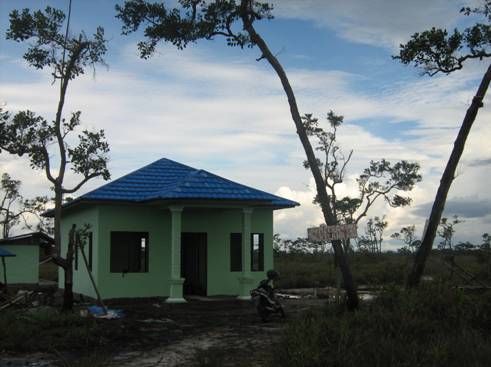
Lakes such as this are vital for the surrounding wildlife, offering an oasis in a very variable habitat. The lake is an important rest site for birds during their long annual migrations. OF’s team recently traveled from the guard post to check up on the lake. When they finally arrived at the lake, a fantastic site awaited them.
Lakes such as this are vital for the surrounding wildlife, offering an oasis in a very variable habitat. The lake is an important rest site for birds during their long annual migrations. OF’s team recently travelled from the guard post to check up on the lake. When they finally arrived at the lake, a fantastic site awaited them. These curious and dubious birds are great egrets- Egretta alba. The nest has three fast growing chicks and the two parents are still hanging around. 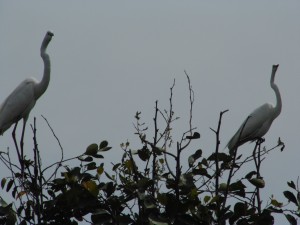
The Great Egret is partially migratory, with birds in the north moving south to avoid cold winters. The species breeds in colonies and prefers to breed in trees which are close to large lakes that have reed beds or inside extensive wetlands. Evidently, this family are using theDanauBurungLakeas it is perfectly suited to their ecology. It’s fantastic for the Foundation to see bird species such as these up close, especially when it gives an insight into their breeding behaviour. These photos were taken in May this year, giving a good reference point for the seasonality of this species migration and breeding.
When the newborns were first found, they were still pristine white eggs. The fact that a mating adult pair use this lake as a nesting site reinforces how pristine and protected this area is – they feel safe enough to nest there. The Great Egret feeds in shallow water or on land, feeding on fish, frogs, small mammals, and the odd small reptiles and insects if needed.
Now the eggs have hatched and the chicks grown through a pink, bald stage into a white fluffy stage - we hope to see more of these individuals as they grown and prepare to fly the nest!
Orangutan rescued
Our vet, Dr Wawan, has written this post about the rescue of a female Bornean orangutan, who had been seen in a village rubber plantation and a nearby oil palm plantation. "We had received information from Bapak Haji Arun and villagers that orangutans have often being seen in Arun’s rubber plantation, eating rubber seeds and bark and also in forest near PT GAP oil plam plantation area.
Our rescue team comprised; PT GAP Oil Palm Plantation (Darman, Erik etc); BKSDA SKW II Kalteng (Muda, As Blek) - Agency for Conservation of Natural Resources; and Orangutan Foundation (Wawan, Tigor, Sariamat, Uduk, Udin).
We arrived on location at 27 june 4.30pm. Based on Pak Erik (PT GAP) information, this place was often passed by orangutans. Sometimes they in rubber plantation at left side of road or sometimes in the forest on the right side. Pak Erik did monitoring for almost two months and he said at least five orangutans often seen there, he also took pictures.
Our team then went to the rubber plantation where we found some nests but no orangutans. We took some photos of the orangutan nests and then as dusk fell, at 6pm, we go to PT. GAP mess to rest.
The next day we arrived on location at 6am, three people had already seen an orangutan in the high branch of tree at the forest area right side of road.
After seeing the orangutan I prepare some darts with anesthetic ‘ketamine hcl’ for estimated 30 Kg body weight.
The deep trench between the road and forest blocked our path. Pak Sariamat, Uduk and I tried to find way around to penetrate the thick bush of forest in order that we could approach the orangutan from behind.
As Blek (from BKSDA) and Tigor stayed on the road to keep watching the orangutan. After a while we came up close to the female orangutan but she see us as well. She begins to intimidate us with her voice and by throwing branches at us.
As Blek and Uduk blew the pipe for several times but all missed because she keep moving all the time, sometime sit on very high tree branches so its impossible for syringe dart reach it, we all think it would be easier with a dart gun. We keep following her for many hours but in the end we feel so tired and give up. After take a rest for a while, we decided to go out from the forest and walk to the main road road. Udin, Orangutan Foundation staff, suddenly saw the orangutan in a tree beside the road. We were surprised and tried to capture her again but even this time we got same result, the orangutan disappeared.
We then decided to check the rubber plantation area. After a short time we found another female orangutan in a rubber tree. We spread our team to surround the target, but it is not that easy, again the orangutan is very active, keep moving. Uduk blew the pipe several times but kept missing. Then we decide to keep follow this orangutan until dusk when she also tired and making a nest for a rest. At 6pm orangutan make a nest and sleeping. We make a sign on that tree and plan to come there tommorow before sun rise.
At 4am the next day we started off to go to the location, day still dark and we use a small flashlight in order to approach to the nest tree. Once there Pak Uduk make a small fire to avoid mosquitos and keep us warm.The orangutan still sleeping in the nest and at 6am as the day brightened she woke and started to move through the rubber trees.
Once she hang on short branch, Uduk blew the pipe and finally the dart needle penetrated her right foot. She still moving and still strong after around 5 minutes. As Blek tried a second dart needle which successfully penetrated on her left thigh. Two minutes later, the orangutan fell.
I give her an examination and she seems healthy. Based from the pattern of teeth she is about 12-15 years age and her body weight was 27.4 Kg.
We finally transported her to Pangkalan Bun where she will be released in the Lamandau River Wildlife Reserve.
I thankyou for all support to this rescue, Orangutan Foundation team, BKSDA SKW II Kalteng and also PT GAP for all facilitations and support.
Dr Wawan - Orangutan Foundation Vet



